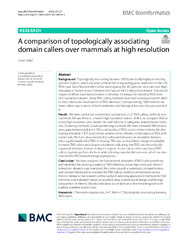A comparison of topologically associating domain callers over mammals at high resolution
| dc.contributor.author | Sefer, Emre | |
| dc.date.accessioned | 2023-06-08T13:03:02Z | |
| dc.date.available | 2023-06-08T13:03:02Z | |
| dc.date.issued | 2022-04-12 | |
| dc.identifier.issn | 1471-2105 | en_US |
| dc.identifier.uri | http://hdl.handle.net/10679/8366 | |
| dc.identifier.uri | https://bmcbioinformatics.biomedcentral.com/articles/10.1186/s12859-022-04674-2 | |
| dc.description.abstract | Background: Topologically associating domains (TADs) are locally highly-interacting genome regions, which also play a critical role in regulating gene expression in the cell. TADs have been first identified while investigating the 3D genome structure over High-throughput Chromosome Conformation Capture (Hi-C) interaction dataset. Substantial degree of efforts have been devoted to develop techniques for inferring TADs from Hi-C interaction dataset. Many TAD-calling methods have been developed which differ in their criteria and assumptions in TAD inference. Correspondingly, TADs inferred via these callers vary in terms of both similarities and biological features they are enriched in. Result: We have carried out a systematic comparison of 27 TAD-calling methods over mammals. We use Micro-C, a recent high-resolution variant of Hi-C, to compare TADs at a very high resolution, and classify the methods into 3 categories: feature-based methods, Clustering methods, Graph-partitioning methods. We have evaluated TAD boundaries, gaps between adjacent TADs, and quality of TADs across various criteria. We also found particularly CTCF and Cohesin proteins to be effective in formation of TADs with corner dots. We have also assessed the callers performance on simulated datasets since a gold standard for TADs is missing. TAD sizes and numbers change remarkably between TAD callers and dataset resolutions, indicating that TADs are hierarchically-organized domains, instead of disjoint regions. A core subset of feature-based TAD callers regularly perform the best while inferring reproducible domains, which are also enriched for TAD related biological properties. Conclusion: We have analyzed the fundamental principles of TAD-calling methods, and identified the existing situation in TAD inference across high resolution Micro-C interaction datasets over mammals. We come up with a systematic, comprehensive, and concise framework to evaluate the TAD-calling methods performance across Micro-C datasets. Our research will be useful in selecting appropriate methods for TAD inference and evaluation based on available data, experimental design, and biological question of interest. We also introduce our analysis as a benchmarking tool with publicly available source code. | en_US |
| dc.language.iso | eng | en_US |
| dc.publisher | BioMed Central Ltd | en_US |
| dc.relation.ispartof | BMC Bioinformatics | |
| dc.rights | openAccess | |
| dc.rights.uri | https://creativecommons.org/licenses/by/4.0/ | |
| dc.title | A comparison of topologically associating domain callers over mammals at high resolution | en_US |
| dc.type | Article | en_US |
| dc.description.version | Publisher version | en_US |
| dc.peerreviewed | yes | en_US |
| dc.publicationstatus | Published | en_US |
| dc.contributor.department | Özyeğin University | |
| dc.contributor.authorID | (ORCID 0000-0002-9186-0270 & YÖK ID 332978) Sefer, Emre | |
| dc.contributor.ozuauthor | Sefer, Emre | |
| dc.identifier.volume | 23 | en_US |
| dc.identifier.issue | 1 | en_US |
| dc.identifier.wos | WOS:000781938200002 | |
| dc.identifier.doi | 10.1186/s12859-022-04674-2 | en_US |
| dc.subject.keywords | Chromatin organization | en_US |
| dc.subject.keywords | Hi-C | en_US |
| dc.subject.keywords | Micro-C | en_US |
| dc.subject.keywords | TAD callers | en_US |
| dc.subject.keywords | Topologically associating domains | en_US |
| dc.identifier.scopus | SCOPUS:2-s2.0-85128158888 | |
| dc.relation.publicationcategory | Article - International Refereed Journal - Institutional Academic Staff |
Files in this item
This item appears in the following Collection(s)
Share this page




